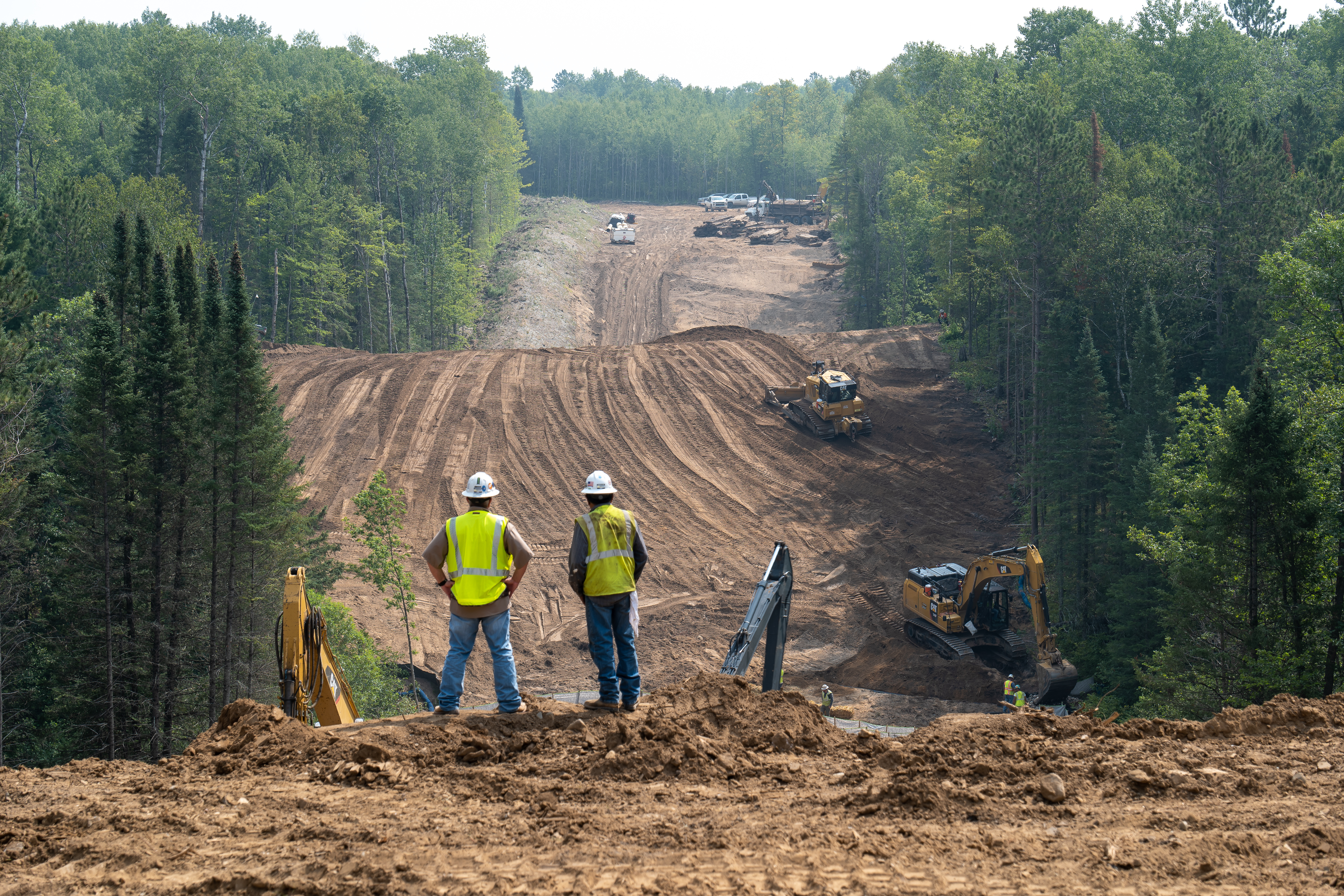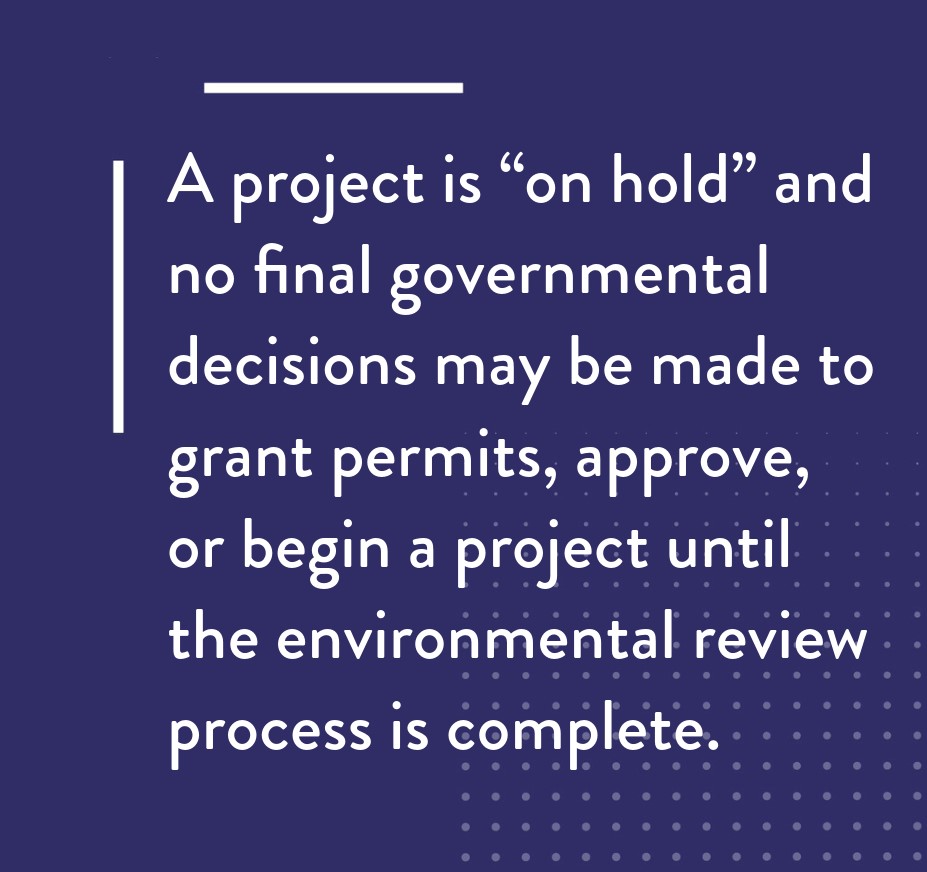Page contents
When is environmental review required?
Who is involved in environmental review?
What is environmental review?
Environmental Review (ER) is an information gathering process to assess the potential environmental effects of a proposed project and identify whether those effects may be significant. ER is not an approval process, but the information gathered is meant to inform project approvals (i.e. permits). ER helps governmental units make more informed decisions on projects and gives the public an opportunity to participate and provide input to decision makers prior to permitting.
Minnesota’s Environmental Review Program requirements are laid out in Minnesota Statute 116D and Minnesota Rules 4410.
The rules describe:
- when review is required
- who conducts the review
- procedures for conducting the review, and
- criteria that must be used for making decisions for environmental review documents
When is environmental review required?
Environmental Review documents are required when a project may have the potential for significant environmental effects. Minnesota Rule 4410 sets forth when environmental review must occur. There are three main types of environmental review- Environmental Assessment Worksheet (EAW), Environmental Impact Statement (EIS), and Alternative Urban Areawide Review (AUAR). The following criteria could trigger environmental review.
Mandatory category
A threshold is triggered by Minnesota Rules 4410.4300 (for EAWs) or 4410.4400 (for EISs). Examples of projects that could fall into a mandatory category are large residential housing developments, mines, energy projects, solid waste facilities, highway projects, projects that alter streams or public waters, and many others. Mandatory categories describe the size and location in which projects require a review.
If a project does not fall within a mandatory category, a Responsible Governmental Unit (RGU) can order a discretionary review if the project may have the potential for significant environmental effects. have the potential for significant environmental effects.
Petition
If an EAW is ordered due to a petition, the RGU that was designated by the Environmental Quality Board (EQB) to act on the petition is responsible for the preparation of the EAW.
Who is involved in environmental review?
EQB
EQB is responsible for monitoring the effectiveness of the program, providing technical assistance in understanding the rules, and responding appropriately to modify and improve the program.
RGU
In Minnesota’s environmental review process, the main responsibilities fall to a designated unit of government, known as the responsible governmental unit. An RGU evaluates petitions, oversees the preparation and analysis of environmental review documents, makes decisions on the ER documents, and can comment on projects from other RGUs during the comment period. The RGU can be any state agency or any local (county, city, township) or special purpose unit (watershed district, SWCD, etc.) of government in the state. Rules specify that the RGU is generally the governmental unit with the greatest expertise or the greatest responsibility to manage a project. Rule does not prohibit government entities from working together on environmental review but one would be listed as the RGU.
Project proposer
The project proposer is the entity or governmental unit that proposes a project that will result in a physical manipulation of the environment, either directly or indirectly.
Members of the public
Members of the public provide input to inform the RGU by providing information and bringing up concerns about the project. During public notice phases of a project, the public can comment on proposed projects. The public can also petition for an EAW for a project that they believe may have the potential for environmental effects.
How is the RGU determined?

For each environmental review project, a RGU is assigned. Different criteria determine which RGU is assigned, depending on the process.
- Projects under Mandatory Categories: A RGU is specified by the corresponding mandatory category. If both an EAW and EIS mandatory category are triggered, the RGU is the one specified by the EIS mandatory category.
- Projects under Discretionary Review: If a governmental unit orders environmental review for a project, it serves as the RGU. A project proposer can also ask that environmental review occur. In this instance, the RGU selection follows Minnesota Rule 4410.0500 Subp. 5.
- Petitions: If a petition is filed, the EQB assigns the RGU according to procedures in rule.
There are times when the RGU can be more complicated to determine. Sometimes there might be more than one government unit that has authority over the project. In that case, the government unit with the greatest overall authority over the project is the RGU.
- If it is unclear who has the greatest authority, or there is a dispute, the governments involved may mutually agree on who will be the RGU.
- If the units cannot reach an agreement, they must submit the question to the EQB chair to decide.
The EQB can change the RGU if another RGU has greater expertise in analyzing the potential environmental impacts of the project (part 4410.0500, subpart 6).
There are instances where a governmental unit is both the project proposer and the RGU. A governmental unit is not disqualified from acting as the RGU simply because it is the project proposer.
Types of environmental review
Minnesota Rule 4410 outlines the different types of environmental review and when they are used.
Environmental Assessment Worksheet (EAW)
An EAW is intended to succinctly assess a project’s potential for significant environmental effects. RGUs are responsible for completing the environmental assessment worksheet that has a standardized list of questions, as maintained by the EQB, to assess the environmental effects that may be associated with a proposed project. The project proposer works with the RGU to complete the worksheet. The RGU completes the review and uses the criteria in rule to decide if the project has the potential for significant environmental effects. If the project does, then the preparation of an Environmental Impact Statement is ordered.
Petitions

The petition process is designed to provide a standard way for members of the public to formally ask for an EAW to be conducted for a project that may have the potential for significant environmental effects. Petitions must include information about the potential environmental effects and the signatures of at least 100 people who live in or own property in Minnesota. The full requirements are outlined in Minnesota Rules 4410.1100. Petitions are sent to the EQB. EQB reviews the petition for completeness; if complete, EQB designates the RGU. The RGU reviews the petition and determines if the project may have the potential for significant environmental effects. If the project may have the potential for significant environmental effects, the RGU orders an EAW.
Environmental Impact Statement (EIS)
The EIS is a thorough study of a project’s potential impacts. The EIS is reserved for projects with the potential for significant environmental effects. It includes a comparative analysis of its economic and sociological effects and considers reasonable alternatives to the project, including the “no-build” alternative. When completed, governmental units use the information for decision making and to determine if the EIS addresses the potentially significant issues for the project and alternatives raised in scoping to ensure the completeness and adequacy of the EIS.
Like the EAW, the EIS is a source of information to guide approval decisions. Occasionally, the information results in an alternative site or design. More commonly, the information suggests changes or mitigative measures to minimize potential impacts that can later be imposed via governmental approvals.
Alternative Urban Areawide Review (AUAR)
Alternative Urban Areawide Reviews are designed to look at the cumulative impacts of anticipated development scenarios within a given geographic area that also has a comprehensive plan. The AUAR is a planning tool that local governments can use to understand how different development scenarios will affect the environment of their community. It is a way of performing an environmental analysis in advance, before major development occurs in an area, and to use the information to guide local planning and zoning decisions. Future projects in the area may not require individual EAW and EIS documents as long as they are consistent with the development scenarios discussed in the AUAR and project proposers implement the mitigation measures required by the AUAR Mitigation Plan.
Additional considerations
Connected Actions
If multiple actions are connected, environmental review may be needed for the project that may not have been required if it was a standalone action. Three types of relationships between projects qualify as connected actions (part 4410.0200, subpart 9c):
- One project induces the other;
- One project is a prerequisite for the other and is not justified by itself (the first occurring previously or simultaneously); or
- Neither project is justified by itself; that is, the two projects are interdependent parts of a larger whole project.
Whenever two or more projects are related in any of these ways, they must be considered as one project, regardless of ownership or timing (parts 4410.1000 and 4410.2000, subparts 4).
One of the more common existing connected actions occurs when independent landowners with adjoining properties jointly design a residential or commercial project without regard to the ownership boundaries. Another type of connected action arises when constructions of a facility would triggers construction of a pipeline that would not otherwise be needed.
Phased Actions
This is defined as two or more projects by the same proposer that an RGU determines will have environmental effects on the same geographic area and are substantially certain to be undertaken sequentially over a limited period of time. (4410.0200, subpart 60). This definition involves three components (all of which must be met to be a phased action):
- Same proposer;
- Same area affected;
- Same timing.
The EQB recommends that the RGU consider the following factors as indicative that project stages are “substantially certain to be undertaken sequentially over a limited period of time:”
- Development rights are being granted for future stages; for example, all parcels given preliminary plat approval or concept plan approval conveying any development rights must be considered part of the same “phased actions.”
- The project proposer is seeking approval for later stages from another governmental unit.
- Detailed plans and specifications have been prepared for future stages. Public infrastructure or support facilities are currently being built to serve future stages.
- Any aspect of the initial stage determines, limits, or tends to prejudice decisions about future stages.
- Any assurances that future stages will not take place within a limited period of time.
- The proposer has constructed other previous stages in the area. Past history may provide evidence about the likelihood and development schedule of future stages.
- Any other factor that impacts the certainty and scheduling of the future stages.
Network projects such as highways, utility systems, and pipelines may be divided for review if “logical in relation to the design of the total system or network and must not be made merely to divide up a large system into exempted segments” (parts 4410.1000 and 4410.2000, subparts 4). However, an unreviewed stage may not be approved or put into construction until the review is completed.
Three-year look back
Minnesota Rule 4410.4300, subpart 1, addresses how to determine whether a proposed expansion of an existing project requires a mandatory EAW. If the proposed expansion does not trigger a mandatory category, it may require an EAW due to the combined size of the existing project and the proposed expansion. The existing project’s magnitude must be added to the proposed expansion under the following conditions:
- Construction of the existing project started less than three years ago (specifically, less than three years before the date the first application was submitted to any governmental unit for the proposed expansion); and
- The existing project was not reviewed through an EAW or EIS.
The purpose of the three-year look back rule is to include previous stages of projects when determining if a mandatory threshold is applicable. An EAW can only review impacts of actions that are not yet permitted or constructed. Existing project components are to be considered as background conditions in the EAW analysis, similar to how other development surrounding the project would be considered.
Exemptions
The ER program also includes exemptions. Specific exemptions for projects based on size, location, or project type are indicated in Minnesota Rules 4410.4600. Exempt projects do not go through environmental review. However, if a project meets one exemption, but also triggers another mandatory category, this project would not be exempt from environmental review.
Cumulative Potential Effects 
Cumulative potential effects are the impacts of projects in the environmentally relevant area on the environment and the accumulation of those projects result in incremental effects. Projects that might reasonably be expected to affect the same environmental resources included future projects that are actually planned or for those which a “basis of expectation” has been laid (regardless of what person undertakes the other projects or what jurisdictions have authority over the projects).
Significant cumulative potential effects can result from individually minor projects taking place over time. In analyzing the contributions of past projects to cumulative potential effects, it is sufficient to consider the current aggregate effects of past actions. It is not required to list or analyze the impacts of individual past actions, unless such information is necessary to describe the cumulative potential effects.
In determining if a “basis of expectation” has been laid for a project, an RGU must consider whether a project is reasonably likely to occur and, if so, whether sufficiently detailed information is available about the project to contribute to the understanding of cumulative potential effects. In making these determinations, the RGU must consider: whether any applications for permits have been filed with any units of government; whether detailed plans and specifications have been prepared for the project; whether future development is indicated by adopted comprehensive plans or zoning or other ordinances; whether future development is indicated by historic or forecasted trends; and any other factors determined to be relevant by the RGU.
Cumulative potential effects are analyzed for a project undergoing environmental review and the RGU considers this when making the determination for an EIS.
Appeals and reviews
Environmental review decisions can be appealed in the Court of Appeals (Minn. R. 4410.0400, subpart 4). The EQB is not an appeal body and cannot appeal an RGU decision; however, it may initiate judicial review or intervene in any proceeding brought under the rules.
Additional resources
The EQB website has guidance, videos, examples, and more information on the individual types of environmental review pages (EAW, EIS, AUAR, and petitions).
The EQB Monitor, a weekly electronic publication by the EQB serves as the official notice for environmental review documents and for the start of associated comment periods. RGUs submit these notices via the online submission form. Sign up for weekly notifications of the EQB Monitor to see proposed projects from around the state.
EQB also recommends frequent discussions occur with the decision makers for the project, Tribal Nations, and the RGU at an early stage in the process.
Below, you can watch a recording of our ER 101: overview webinar given by EQB staff in April 2025, and ER 101: using the submittal service offered by staff in October 2025.
Contact Us
 Have questions? EQB staff are available to walk RGUs, project proposers, and the public through the environmental review process. Contact EQB staff at 651.757.2873 or by email at env.review@state.mn.us.
Have questions? EQB staff are available to walk RGUs, project proposers, and the public through the environmental review process. Contact EQB staff at 651.757.2873 or by email at env.review@state.mn.us.